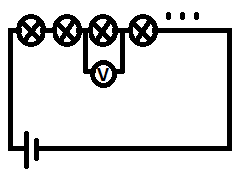A row of 15 decorative lights, connected in series, is connected to a power supply. When the supply is switched on, the lights do not work. The owner uses a voltmeter to test the circuit. When the voltmeter is connected across the third bulb in the row of lights, a reading of zero is obtained.
Which of the following cannot be the only fault in the circuit?
- The filament of the third bulb has broken
- The fuse in the mains transformer has blown
- The filament of one of the other bulbs has broken
- There is a break in the wire from the supply to the transformer
The terminal voltage of a battery is observed to change when the battery supplies a current to an external resistor.
What quantities are needed to calculate the change in voltage?
- the battery’s e.m.f. and its internal resistance
- the battery’s e.m.f. and the current
- the current and the external resistance
- the current and the internal resistance of the battery
Show/Hide Answer
When no current passes through the external resistor, the terminal voltage of a battery is given by the e.m.f. of the battery.
When a current passes through the external resistor, the terminal voltage of a battery is given by the potential difference across the external resistor = IR = $\epsilon – Ir$.
From the above equation, we can see that the change in voltage is $- Ir$.
Answer: 4
3 is not the answer as you will need the $\epsilon$ in addition to the current and external resistance to calculate the change in voltage.
